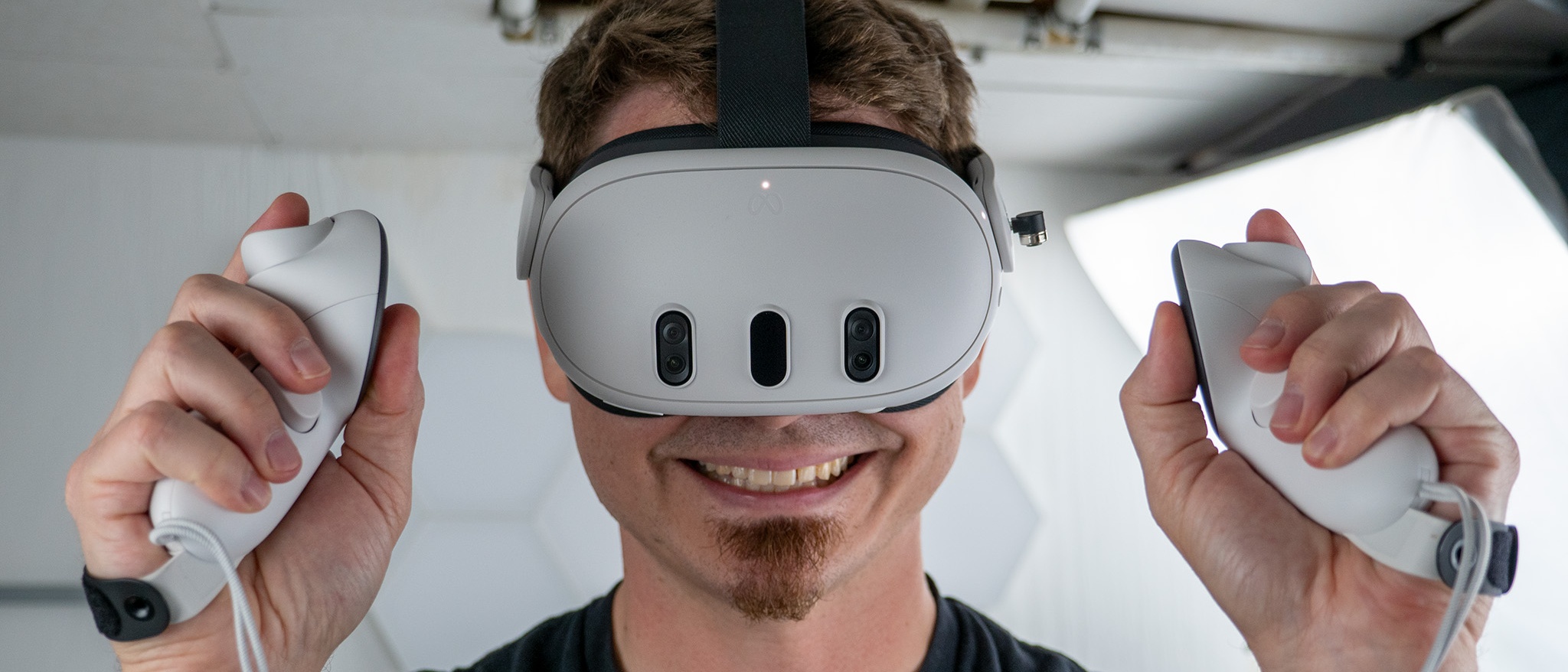Android Central Verdict
The Meta Quest 3 is a superb follow-up to the most successful VR headset of all time. It addresses many complaints we had about the Quest 2 including better lenses with proper IPD adjustment, a significantly slimmer frame, better software, and better cameras for mixed-reality capture. You'll still need some 3rd-party accessories to get the best experience, though, which is a huge negative given the substantial price increase over the Quest 2.
Pros
- +
Incredible visual upgrade
- +
Superb lenses with granular IPD adjustment
- +
Mixed reality looks much better
- +
Controllers feel great to use
- +
Tons of games available
- +
Lots of developer support
Cons
- -
Cloth strap does little to help the weight
- -
A lot more expensive than Quest 2
- -
Lenses still fog up
- -
Battery life is not good
Why you can trust Android Central
In 2020, Meta changed VR forever when it launched the (then called) Oculus Quest 2, a cheaper, far more powerful headset than its predecessor. The Meta Quest 3 debuted three years later, bringing about substantial improvements in performance, design, visual clarity, substantially improved performance, and a new mixed reality paradigm, all with a $200 price increase over the Quest 2.
The Meta Quest 3 has been successful in the past year but nowhere near as popular as the Quest 2, almost certainly because of the price. There's just no denying how important $299 was for VR, and that's why Meta would go on to debut the Meta Quest 3S a year later at that $299 price.
And while the Meta Quest 3S delivers 90% of what the Quest 3 offers, there's still no denying that the Quest 3 provides the best overall visual experience. Going from the Quest 3S's Fresnel lenses to the pancake lenses in the Quest 3 feels like a generational leap. It's akin to swapping out your old 720p TV with a 4K TV, even if Meta's default cloth strap doesn't help make the fit feel more premium out of the box.
Meta Quest 3: Price & availability

The Meta Quest 3 initially launched in two configurations, one with 128GB of storage and one with 512GB of storage. Since then, Meta has discontinued the 128GB model and reduced the 512GB model's price to $499, down from $649 originally.
Meta also packs in a free copy of Batman Arkham Shadow with every Quest 3, the first Batman Arkham game in a decade and one of the best-reviewed entries in the series to date. Each Quest 3 also comes with three free months of Meta Quest Plus, giving you access to 23 games out of the box. Quest Plus includes 2 free games per month, plus access to a revolving library of 20 games that's refreshed every so often.
Meta Quest 3: Design and comfort

First and foremost, the Meta Quest 3 is designed as a mixed-reality headset. That doesn't mean the virtual reality experience is worse because of it — far from it, actually — but it does mean that Meta was able to take the experience to the next level by using mixed reality as a tool to reduce friction.
You'll hear the term "friction" a lot in reference to VR, and it's particularly important because VR is inherently less convenient to use than traditional mediums. Sure, putting a headset on and grabbing controllers is just as many steps as grabbing your PS5 controller, turning on the TV, and sitting on the couch, but there's something about the human experience that makes a VR headset feel like more effort.
The Quest 3 is quite heavy despite its thinner design, and the cloth straps did little to alleviate the pressure on my face.
For this (and other reasons), Meta kept the cloth strap concept alive as it's the simplest way to use a headset, particularly if only one person in a household is using it. The new cloth straps certainly look similar to the old ones but offer more support thanks to a split overhead strap design.
But while they come in some trendy and attractive new colors and materials, this cloth strap did little to alleviate the pressure on my face from the heavy Quest 3. Yes, despite being 40% thinner, the Quest 3 actually weighs just a little bit more than the Quest 2.

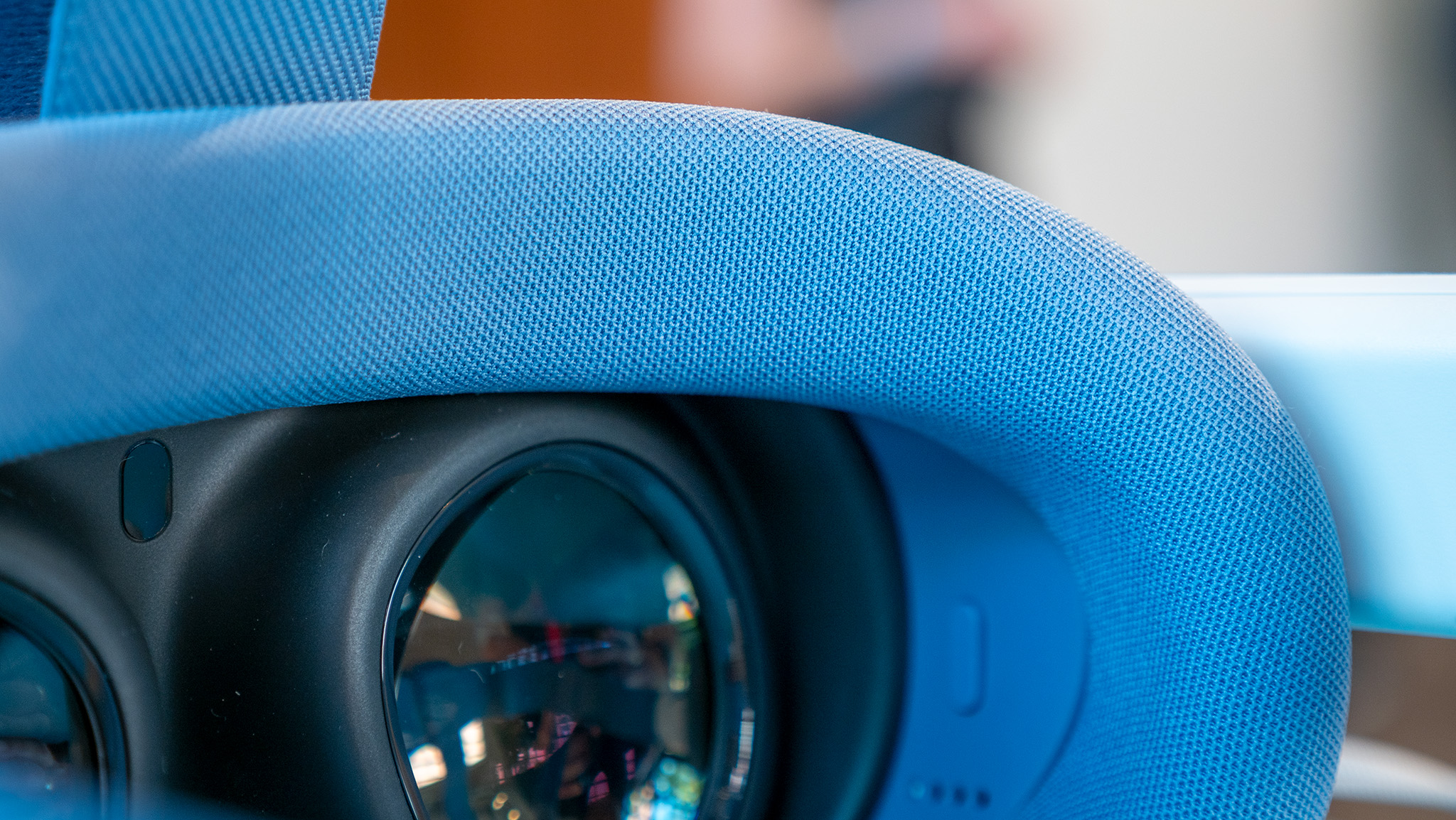



Meta also sent me one of its official Quest 3 Elite Straps to review and while it is a far better design than the cloth straps, it still falls short of the best Meta Quest 3 accessories available, like the BoboVR M3 Pro head strap replacement.
The lenses get less foggy than the Quest 2, but you'll still need to buy a 3rd party face pad to completely alleviate lens fog.
While the new breathable fabric and redesigned facial interface help alleviate fog better than the Quest 2, I regularly had the Quest 3's lenses fog up on me during the first five minutes of playtime. Considering the best Quest 2 face pads from Kiwi Design solved this problem years ago, it's incredibly frustrating to see it crop up again in Meta's design.

Thankfully, glasses users will no longer need to add a glasses spacer thanks to some clever thinking on Meta’s part. The face gasket itself can adjust depth this time around, with four-step options to choose from to best fit most faces, particularly ones with glasses.

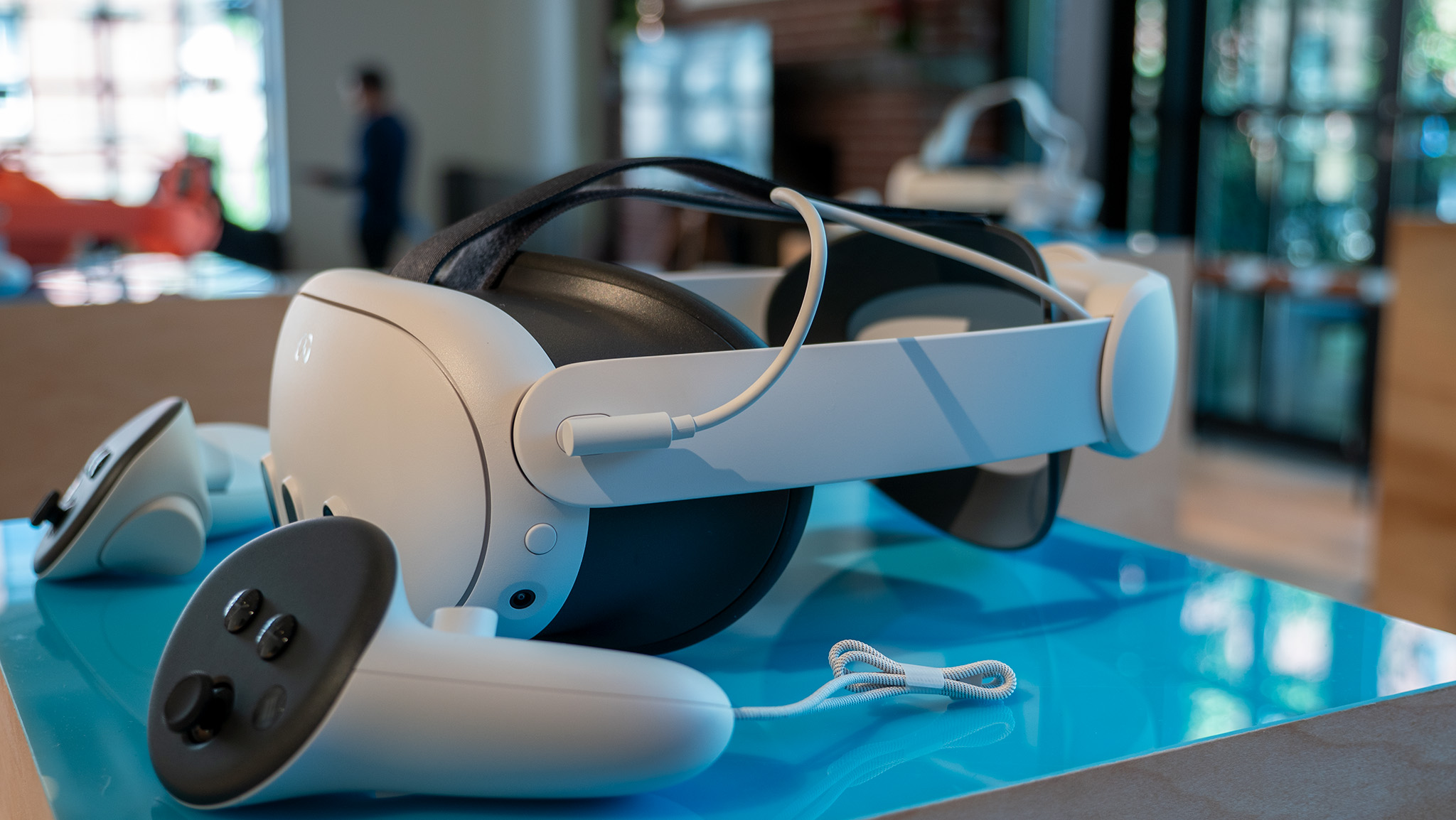


IPD adjustment on the Quest 2 and Quest 3S leaves a lot to be desired and is easily one of the biggest negatives of either headset. Thankfully, Meta has combined the best parts of the original Oculus Quest — an IPD adjustment wheel — with further improved pancake lenses versus the more expensive Quest Pro.





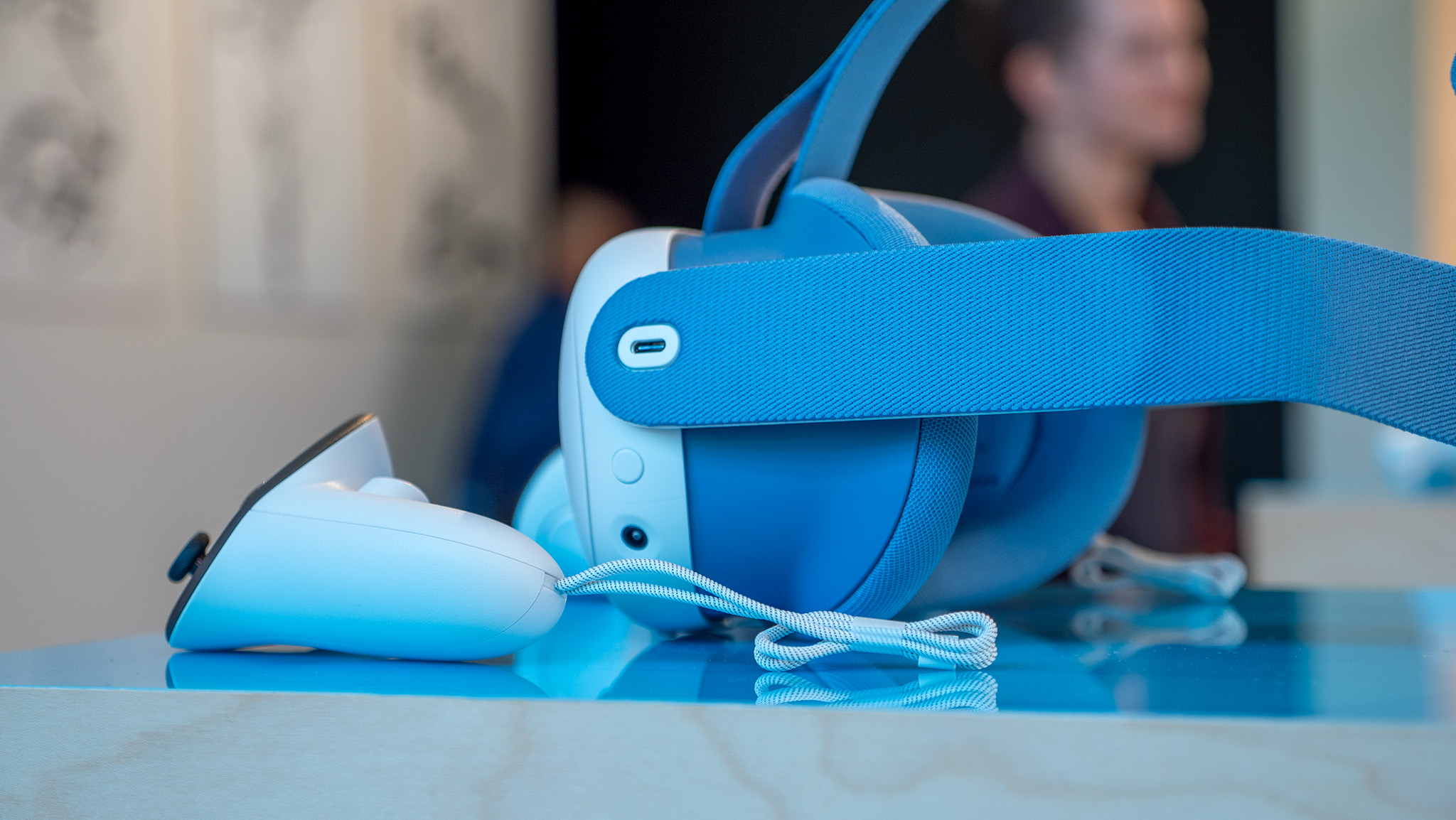
That combination is supremely comfortable and means that the Quest 3 supports a wider range of IPD values, no longer has that nasty little "sweet spot" Quest 1 and 2 lenses had, and is easily adjustable while wearing the headset — take that, Quest Pro.
Meta Quest 3: Mixed reality is key

The moment you put the headset on, you'll be treated to a view of the room around you using these new, significantly improved cameras. They're not Apple Vision Pro-level quality, but at 1/7th the price of that product, I wouldn't expect them to be. That doesn't mean it's bad by any means, but I know people will be surprised at the quality improvement over other Quest headsets.
In fact, the mixed reality games I've played are convincing because the camera quality finally matches the quality of the objects the Quest 3 rendered. In the new First Steps experience on the Quest 3, players will be blasting little aliens that appear to jump through the walls and ceiling of the room.
The mixed reality games I've played so far were convincing because the camera quality finally matched the quality of the objects the Quest 3 rendered.
This is far more convincing than previous efforts because the objects cast shadows on the ground, hide behind objects in the room, and look far more realistic, thanks to improvements in lighting quality and external camera quality.
But none of this would be particularly fun if the Quest 3's room setup was as tedious as with previous headsets. This time around, the Quest 3 includes a depth sensor and cameras with 10x the resolution of the Quest 2, offering automatic room mapping that just requires you to look around as it recreates your room in virtual reality.
This effect was nearly identical to how it's presented on the PSVR 2 and felt great to use. The headset can even help create safe room-scale boundaries to keep you from running into furniture. Plus, if you run the additional spaces room setup, you can define couches, tables, and other objects that can be used in virtual space.
The Quest 3 automatically identifies walls, ceilings, and furniture and will give you a virtual representation of those objects in-headset thanks to the new depth sensor.
Not only that, but the moment you put the headset on, you'll see the world around you in glorious, high-resolution, full-color, clean video. That last part is particularly important because the Quest Pro offered full-color video at a higher resolution than the Quest 2 but didn't do a great job with clarity.
The Quest 3's video is super clean and obviously has a strong denoise algorithm placed atop to keep noise in dark rooms at a minimum. I'm able to actually look out my window, watch TV, and even read my phone screen without taking the headset off.




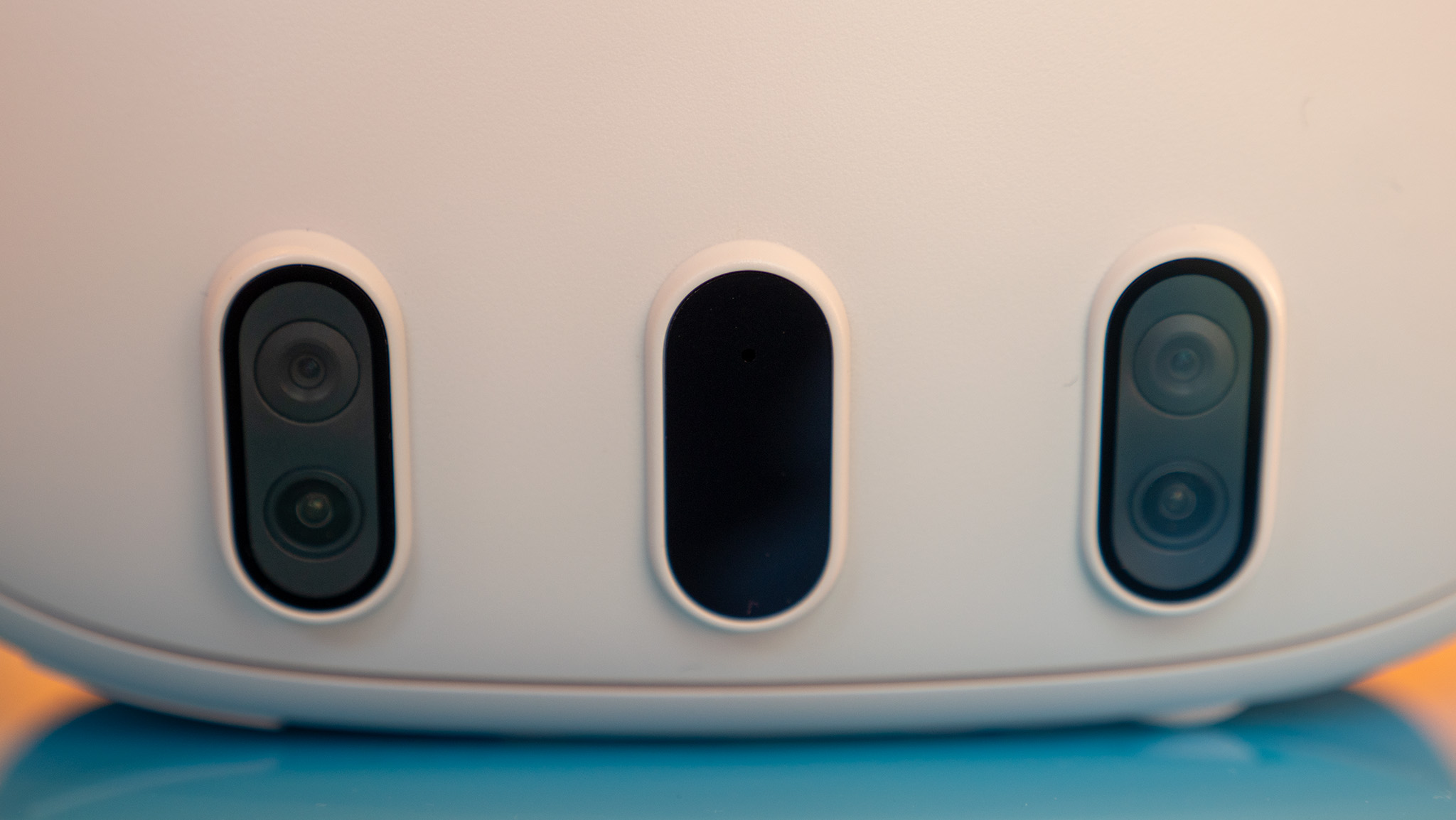
The mixed-reality camera quality is so clear I can actually read my phone or Pixel Watch while wearing the headset.
Since launch, Meta has further improved mixed reality passthrough video quality, including reducing overall noise, balancing colors and bright light sources better, and even almost completely removing the distortion that used to occur with motion.
Meta has also reworked the UI several times since launch, now supporting multitasking with floating windows, more 2D apps, and better integration with services like Xbox Game Pass.
Meta Quest 3: New controllers

Meta's new Touch Plus controllers will feel immediately familiar to anyone who's ever used an Oculus headset before, but they're obviously improved over the predecessors. Meta used the overall design of the Quest Pro Touch Pro controllers here, including the removal of the LED tracking ring that adorned all previous generations of tracked Oculus controllers.
The controllers still have tracking LEDs situated across the body to help track, but Meta has been able to use AI to radically improve tracking overall. That means fewer dead zones than Quest 2 controllers and quicker movements. I actually have a hard time fooling these controllers, even when holding them behind my head when shooting bow and arrow in games like Dungeons of Eternity.
Improved computer vision and AI tricks mean better tracking with fewer deadzones than the Quest 2.
What's particularly fascinating is that Meta says, "The big leap with tracking improvement was all done with computer vision," meaning we should expect big improvements over time.



Samba De Amigo is a brilliant reboot of a Dreamcast and arcade classic, and the experience is sublime on Quest 3. The tracking is perfect and worked exactly as I had hoped. It's even better than the arcade original since there are no wires tethering the maracas — controllers, in this case — to an arcade cabinet.
Part of this improvement is that the headset is tracking your hands at all times. This plays into a recent Quest hand tracking update that improved hand tracking speed by 75% and now allows players to instantly switch between controller and hand tracking, a massive improvement over how the tech used to work. Since launch, Meta has further improved hand tracking and it now works better than ever, with more games and apps supporting it than ever.
Mixed controller and hand tracking make using the UI more effortless than previous offerings.
Despite the removal of the rings and the reduction in the number of tracking LEDs, Quest 3 controllers track better than Quest 2 controllers ever hoped to.
All the control improvements play into the huge steps Meta has taken this year to add in things like the Direct Touch UI. It's just nicer to be able to tap an app's tile with your finger to begin an experience rather than dealing with a finicky app drawer or overly pushy store experience being the first thing you see.



Meta is still using AA batteries to power the Quest 3, and battery life is expected to be as long as the Quest 2's controllers. I'd recommend picking up some rechargeable batteries if you don't already have some.
The redesigned battery door still snaps in with plastic clips like the Quest 2, but these clips will no longer release on their own when pressure is applied. Instead, you'll press a button to release the door in order to get to the battery. It's a small quality-of-life improvement that should help keep battery doors closed when they should be.
This might actually be my favorite part of the redesign, as it allows for some incredibly dope accessories that just snap into the battery door and don't require complicated installation.
Meta Quest 3: Graphics and battery life

The Qualcomm Snapdragon XR2 Gen 2 that powers the Meta Quest 3 offers 100% more GPU processing power than what's in the Quest 2. To better understand that number, the average graphics card upgrades on PCs only improve GPU processing power by 20-30% each generation at the most. In other words, this is the equivalent of upgrading your PC after roughly four years, and the end result genuinely feels like it.
Red Matter 2 is one of the best games you can use to demonstrate the difference between Quest 2 and 3. That's no surprise since the developers regularly push the limits of what hardware can do, no matter the platform. Even the intro loading screen was mind-blowing to look at as the "cursor" from my hand emitted a faint ball of light that could be used to illuminate surfaces of the rocky red planet I was standing on.
The first thing I noticed was the massive improvement in texture resolution. The quality feels straight out of a PSVR 2 game and not something running on a mobile chipset. Subsequently, the improvement in clarity brought on by the 30% upgrade in display resolution and the pancake lenses cannot be understated.
This is the biggest improvement in graphical fidelity I've yet seen between any VR headset generation.
And the visuals don't just look crisper and cleaner; they're also more functional. I was easily able to read text on pages I picked up in the game, a far cry from most current-generation VR headsets that often offer a "translation" option for in-game objects that will display large, plain text overlaid on the virtual paper.
In fact, games like Hubris are using the same textures from the PSVR 2 and PC versions of the game on the Quest 3, showcasing just how big a difference the hardware is.
This is the biggest improvement in graphical fidelity I've yet seen between any VR headset generation.
That makes things far more immersive, too, since you don't have to think about pressing additional buttons just to be able to perform a basic task like reading. I was also able to make out fine details on objects like bottles, something that's not possible on a Quest 2 both because of the foggy lenses and the processing power differences.
Since launch, several Quest 3-exclusive games have debuted including Batman Arkham Shadow. Many other titles have received Quest 3 enhancements, and all new titles have at least some visual enhancements for the Quest 3, even if they are still primarily developed for the Quest 2 in mind.
Now that the Quest 3S is out, more developers will be switching to developing for the Snapdragon XR2 Gen 2 chipset that powers both the Quest 3 and 3S, meaning games in 2025 and beyond will start to look even better.
Battery life is slightly worse than the Meta Quest 2, coming in at just under 2 hours per charge for me.
Unfortunately, none of this means that the Quest 3's battery life is any better than the Quest 2. In fact, I'd wager it's just slightly worse, and I struggle to even get two hours of battery life out of a single charge.
For this reason — and just plain comfort — I'd recommend swapping out that cloth strap with a Kiwi H4 or Yoges Y13 battery strap as soon as possible. They're the two best straps available and offer different comfort fits than the stock strap.
Meta Quest 3: Competition

Meta's only real competition is itself, especially in the standalone VR space. The Meta Quest takes up around 80% of the VR market for a reason, mainly because of cost, ease of use, and thousands of games available.
The Meta Quest 3S is the most compelling alternative to the Quest 3 for several reasons. While it uses the Quest 2's older lenses and display, it has the same powerful chipset as the Quest 3, the same excellent controllers as the Quest 3, and supports all Quest 3-exclusive and enhanced games, all for $200 less. Since both the Quest 3 and Quest 3S support Steam VR, they also double as excellent, affordable PCVR headsets.
The only other VR headset likely worth buying now is the PlayStation VR2. Sony's support of the PSVR 2 has been lackluster, at best, with only a handful of exclusive titles in the nearly two years it's been out. But, the games that are available almost all offer substantially improved visuals over their Meta Quest versions, including more advanced haptic feedback and the deep colors and blacks of its OLED display. Still, this one isn't worth buying unless you already have a PS5.
Meta Quest 3: Should you buy it?
You should buy it if....
- You want the best VR gaming experience ever.
- You want a huge upgrade in graphics and clarity over the Quest 2.
- You're interested in mixed-reality experiences.
You shouldn't buy this if...
- You don't want to spend extra money on accessories for the best experience.
- You're not interested in VR.
The Meta Quest 3 is the best VR headset I've ever used. There's no denying how much work Meta has put into the development of this next-generation VR headset, and it shows in just about every way. From better graphics to increased clarity, better controllers, louder audio, slimmer hardware, and a substantially better software experience than ever before, this is the VR headset to buy.
Just keep in mind that you'll need to spend extra money to get the best experience since the included face pad and cloth head strap are still a bit uncomfortable. Thankfully, 3rd-party companies offer compelling alternatives to Meta's expensive accessories, all while offering better comfort options and extended battery life.
If you care about getting the best standalone VR gaming experience, you need a Quest 3. It's really as simple as that.

The Meta Quest 3 is the best VR headset you can buy, thanks to a new chipset that that's 100% faster than the Quest 2. Games not only play well, but they look much better, and the full-color passthrough lets you see the world around you with ease.

You must confirm your public display name before commenting
Please logout and then login again, you will then be prompted to enter your display name.
